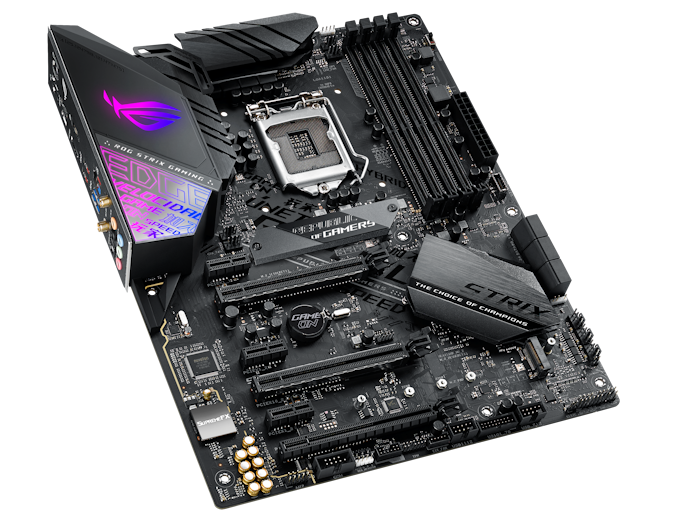Intel Z390 Motherboard Overview: 50+ Motherboards Analyzed
by Ian Cutress & Gavin Bonshor on October 8, 2018 10:53 AM EST- Posted in
- Motherboards
- Intel
- MSI
- Gigabyte
- ASRock
- EVGA
- Asus
- NZXT
- Supermicro
- Z390
The ASUS ROG Strix range of motherboards slot right in between the Maximus XI and TUF Gaming ranges but with a mixture of features and traits from both ranges to keep pricing competitive with other vendors mid-range offerings. These affordable models do have a good range of overclocking, but without the extreme components and more importantly, without the larger price tags associated with the higher echelon of Maximus XI models.
ASUS ROG Strix Z390-E Gaming
The ASUS ROG Strix Z390-E is another Z370 model to get an overhaul of sorts ready for the new 9th generation Intel processors. The newer Strix Z390-E looks relatively similar in terms of PCB space. The main differences come visually with the new Z390-E having primarily black themed heatsinks with a customizable RGB ROG logo with ROG Edge holographic branding towards the bottom of the rear panel cover. The chipset heatsink features the Strix branding and has a metallic grey and black monotone design.
Across the center of the board are three full-length PCIe 3.0 slots which run at x16, x8 and x4 which means two-way SLI and up to three-way CrossFire multi-graphics card configurations are supported. The Z390-E also has three PCIe 3.0 x1 slots which give users one less than the previous Z370-E. Storage wise the Z390-E has two M.2 slots with one dedicated to just PCIe 3.0 x4 drives and the second allowing for both PCIe 3.0 x4 and SATA drives to be used; both M.2 slots have inclusive heatsinks. The board also has a total of six SATA ports with support for RAID 0, 1, 5 and 10 arrays. There are four RAM slots with official support for up to DDR4-4266 with a total capacity of up to 64 GB.
On the rear panel of the mid-ranged Strix Z390-E Gaming is a varied selection of input and outputs. USB support consists of three USB 3.1 Gen2 Type-A, one USB 3.1 Gen2 Type-C, two USB 3.0 Type-A and two USB 2.0 ports. A pair of video outputs consisting of a DisplayPort and HDMI are featured, along with a PS/2 combo port, an Intel I219V Gigabit controlled LAN port and connectors for the 2T2R 802.11ac Intel 9560 Wi-Fi adapter. Finishing off the rear panel is five 3.5 mm audio jacks and a single S/PDIF optical output powered by the ROG SupremeFX S1220A HD audio codec.
The ASUS ROG Strix Z390-E Gaming pricing is unknown at present and represents the most feature-rich of the Strix branded gaming motherboards. The main difference between the Z390-E Gaming and the other ATX sized Z390 Strix based models are the inclusion of the 1.73 Gbps capable Wi-Fi adapter with Bluetooth 5 connectivity support; this is one of the main reasons for the increase in price too.












79 Comments
View All Comments
Smell This - Tuesday, October 9, 2018 - link
Much.Of.
The.
Same.
2 HSIO lanes per Gen 2 port and WiFi. Wow (rolling I-eyeballs) ...
MadAd - Tuesday, October 9, 2018 - link
58 motherboards, only 13 of which are smaller than ATX. When on earth are we going to move off this outdated oversized format? Its just more of the same every time, so depressing.gavbon - Wednesday, October 10, 2018 - link
13 is better than 0, or 12 :DMadAd - Wednesday, October 10, 2018 - link
Considering very small form formats (ITX) are harder to build for and only 7 are uATX, a size which is the most useful to transition away from ATX then no, it feels like an afterthought from a lazy industry. I mean who uses more than 1 main video card and 2-4 sticks of ram in a gaming PC these days? Even water builds into uATX isnt that hard to accomplish.After literally decades ATX should be a choice for edge cases not a mainstream build.
shaolin95 - Monday, October 22, 2018 - link
who cares about midge boards!Edkiefer - Wednesday, October 10, 2018 - link
All these MB with 2x 8 pin power inputs, is both mandatory and if so I guess new PSU will need 2x 8pin now.entity279 - Wednesday, October 10, 2018 - link
so it's ok to just buy SM motherboards now with them being involved in a security scandal?gavbon - Thursday, October 11, 2018 - link
I currently have the Supermicro C9Z390-PGW awaiting to go on the test bench next week, so from a consumers standpoint, I could potentially shed light on that board. As far as the Chinese/Supermicro/Spy scandal goes, I don't want to speculate without the finer details.eastcoast_pete - Wednesday, October 10, 2018 - link
Ian & Gavin, thanks for the overview.@ both - Question: I've read that Intel, to deal with its bad planning/capacity problems on 14 nm, has contracted the fabbing of some of its chipsets out to TSMC, specifically in TSMC's 22 nm tech. Is that correct, and did you have a chance to confirm that the new 390s used by these boards are indeed made by Intel on their 14 nm FinFET tech, or are they made by a contractor (TSMC)?
DanNeely - Wednesday, October 10, 2018 - link
AFAIK the chipsets being reverted to 22nm are using Intel's 22nm process in old unupgraded fabs. Doing so would be far less work than porting to a process from a different company; the latter would require massive rework to follow a completely different set of design rules.